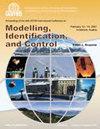变形翼在Hydra Technologies UAS-S4上的应用
IF 0.7
4区 计算机科学
Q4 AUTOMATION & CONTROL SYSTEMS
引用次数: 4
摘要
本文介绍了在Hydra Technologies公司的UAS S4 Ehecatl上进行的变形机翼研究的空气动力学结果。只考虑了飞机的巡航阶段(恒定高度和恒定速度)。从气动的角度来看,通过计算和比较变形机翼和原始机翼的纵向气动系数(阻力和升力)来强调它们之间的差异。利用旋涡格点法对龙卷风的气动特性进行了计算。本文章由计算机程序翻译,如有差异,请以英文原文为准。
Morphing wing application on Hydra Technologies UAS-S4
This paper presents the aerodynamic results of a morphing wing study performed on the UAS S4 Ehecatl from Hydra Technologies. Only the cruise phase of the aircraft was considered (constant altitude and constant speed). The difference, from an aerodynamic point of view, between the morphing wing and the original wing was emphasized by computing and comparing their longitudinal aerodynamic coefficients (drag and lift). The computation of the aerodynamic characteristics was done using tornado with the Vortex Lattice Method.
求助全文
通过发布文献求助,成功后即可免费获取论文全文。
去求助
来源期刊

Modeling Identification and Control
工程技术-计算机:控制论
CiteScore
3.30
自引率
0.00%
发文量
6
审稿时长
>12 weeks
期刊介绍:
The aim of MIC is to present Nordic research activities in the field of modeling, identification and control to the international scientific community. Historically, the articles published in MIC presented the results of research carried out in Norway, or sponsored primarily by a Norwegian institution. Since 2009 the journal also accepts papers from the other Nordic countries.
 求助内容:
求助内容: 应助结果提醒方式:
应助结果提醒方式:


